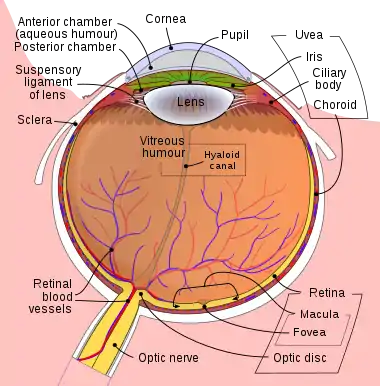Intraocular hemorrhage
Intraocular hemorrhage is bleeding (hemorrhage) into the eyeball (oculus in Latin. It may be the result of physical trauma (direct injury to the eye) or medical illness. Severe bleeding may cause high pressures inside the eye, leading to blindness.
| Intraocular hemorrhage | |
|---|---|
 | |
| Schematic diagram of the human eye en | |
| Specialty | Ophthalmology |
Types
The types of ocular hemorrhages are classified based on where the bleeding is occurring:
- Subconjunctival hemorrhage (bleeding just underneath the conjunctiva)
- Intraocular hemorrhages:
- Hyphema (in the anterior chamber)
- In the posterior segment of eyeball:
- Vitreous hemorrhage (into the vitreous)
- Subretinal hemorrhage (under the retina)
- Submacular hemorrhage (under the macula)
Causes
Different causes may cause bleeding in different locations.
- Terson's syndrome (as a result of subarachnoid hemorrhage)
- Hemophilia (a severe bleeding disorder, usually hereditary)
- Anticoagulants and thrombolysis (medication to reduce blood clotting tendency or to disperse blood clots, respectively)
The major causes of bleeding are injury diabetes mellitus hypertension.
Diagnosis
Intraocular hemorrhage is typically diagnosed with slit lamp examination.
References
This article is issued from Wikipedia. The text is licensed under Creative Commons - Attribution - Sharealike. Additional terms may apply for the media files.